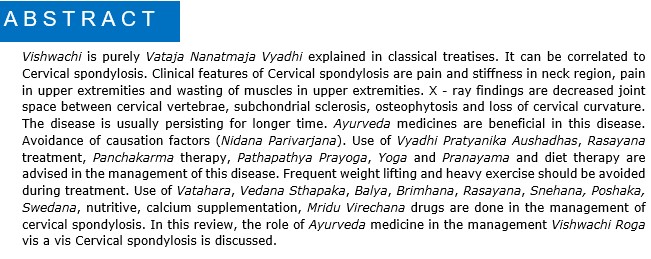Role of Ayurveda medicine in the management of Vishwachi Roga vis-a-vis Cervical Spondylosis
DOI:
https://doi.org/10.21760/jaims.8.11.17Keywords:
Vishwachi Roga, Rasayana, nutritive, cervical spondylosisAbstract
Vishwachi is purely Vataja Nanatmaja Vyadhi explained in classical treatises. It can be correlated to Cervical spondylosis. Clinical features of Cervical spondylosis are pain and stiffness in neck region, pain in upper extremities and wasting of muscles in upper extremities. X - ray findings are decreased joint space between cervical vertebrae, subchondrial sclerosis, osteophytosis and loss of cervical curvature. The disease is usually persisting for longer time. Ayurveda medicines are beneficial in this disease. Avoidance of causation factors (Nidana Parivarjana). Use of Vyadhi Pratyanika Aushadhas, Rasayana treatment, Panchakarma therapy, Pathapathya Prayoga, Yoga and Pranayama and diet therapy are advised in the management of this disease. Frequent weight lifting and heavy exercise should be avoided during treatment. Use of Vatahara, Vedana Sthapaka, Balya, Brimhana, Rasayana, Snehana, Poshaka, Swedana, nutritive, calcium supplementation, Mridu Virechana drugs are done in the management of cervical spondylosis. In this review, the role of Ayurveda medicine in the management Vishwachi Roga vis a vis Cervical spondylosis is discussed.
Downloads
References
Nadakarni KM. Indian Materia Medica. Vol 2. Mumbai: Popular Prakashan Private Ltd; 2002. p. 968.
Rastogi RP, Mehrotra BN. Compendium of Indian Medicinal Plants. Vol 1. Lucknow: CDRI; 1960-1969. p. 515.
Srinivasulu M. Clinical Diagnosis in Ayurveda. Delhi: Chaukhamba Sanskrit Prathishtan; 2013. p. 612.
Rajeshwara Datta Shastri. Chikitsadarsha Sampoorna. 5th ed. Varanasi: Chaukhamba Vishwa Bharathi; 1980. p. 230.
Haridas Vaidya. Chikitsa Chandrodaya. 7th Vol. 11th ed. Madhura: Haridas and Company Ltd; PP 908.
Sharma AK. Kayachikitsa. Part II. Delhi: Chaukhamba Orientalia; 2013. p. 950.
Vaishya S. Vanga Sena. Mumbai: Khemaraja Srikrishnadas Prakashana; 1996. p. 1096.
Acharya S. Researches in Ayurveda. Manipal: Shripathi Acharya; 2010. p. 140.















